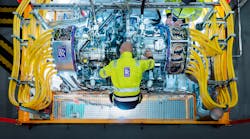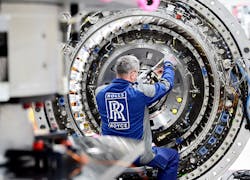When a business leader at Rolls-Royce wants cash for smart factory upgrades, they need to appear on Dragon’s Den.
Okay, not the actual reality series where entrepreneurs compete for the attention and investment funds of a panel of VCs (the British equivalent of ’Shark Tank,’ if you’re not familiar), but close. Rolls-Royce businesses have to make a good pitch to win centrally secured smart factory funding.
The first Silver Ghost automobile rolled off the Rolls-Royce lines in 1921. Today, BMW owns that automotive brand and the "real" Rolls-Royce makes jet airplane engines, other civil and military aerospace components and develops hydrogen fuel cells. As a manufacturer of such long standing, Rolls-Royce plants run the gamut from modern greenfield facilities to old brownfield plants. The generates a diverse demand (and need) for smart factory upgrades that necessitates prioritization of effort.
“We do a rapid assessment, like a discovery into their areas… They need to have the needs and the forms to deploy the technology and create the business outcomes,” Rashitha Jayasekara, chief of Digital Manufacturing at Rolls-Royce said on May 16, 2023, at the PTC LiveWorx 2023 conference in Boston, Massachusetts. “And, we invest, just like in Dragon’s Den, in the top candidates.”
The business units able to meet the challenges laid out by Jayasekara in his presentation, “Scaling Smart Factory Beyond Pilots,” have a leg up in the competition.
When to Pilot, When to Scale
Rolls-Royce began working with PTC to conduct multiple pilots at varying levels of complexity, hoping to discover technologies that could scale to up to a dozen different plants. Deciding which pilots to scale ultimately came down to the opinions of the early adopters.
“Do we [commit the resources to] upscale ourselves to the right place so we have the internal expertise? Do our people, our engineers on the digital manufacturing side really understand the technology? Are our shop floor operators, or whoever the end users are, at a point where they’re happy with the technology?” Jayasekara said.
Successfully implementing the technology at scale comes down to:
- Vendors, business leadership and technology leadership aligning at the highest levels
- Extended technology teams successfully explaining new implementations to management
- Diverse left-brain/right-brain thinking to understand tech deployments holistically and fully engage user communities
Implementation teams' ability to consider diverse audiences becomes especially important when some Rolls-Royce plants may produce low volumes of high complexity parts while others produce high volumes of simple parts.
“If you go onto the shop floor of a smart factory… people looking at those digital products, digital dashboards, using the technology, it’s about them. So, how do we really engage them in the whole development process, to get what they need?” Jayasekara says.
Finally, Jayasekara stressed the importance of partnerships with technology providers. Manufacturers have to assess honestly their internal capacity for technical resources and the ability to communicate with and inform all the constituencies affected by the introduction of a new technology. Technology partners provide flexibility, an absolute necessity when it’s time to scale out the pilot.
Maximizing Tech Deployment Value
Jayasekara says Rolls-Royce is ’ruthless’ when assessing the value of a smart factory technology, like ease and potential breadth of deployment. If the company has hundreds of a certain type of machine used across multiple plants, a smart factory upgrade can improve its performance, that obviously stands a greater chance of attracting funding compared to upgrades for a lesser-used machine.
These common sense considerations, like aligning smart factory programs capabilities with the business outcomes that are really important to the company, come from the leadership teams.
“They can see this is not just an IT program. If I do these things and change my business in this particular way, I am going to get my business outcomes a little bit quicker,” Jayasekara says.
Rolls-Royce achieves agile delivery by rolling PTC advisors, Rolls-Royce experts and managed service teams into “sprint teams“ that can change the scope of a deployment as they better understand the technology, rather than running smart factory deployments like traditional IT deployments with inflexible milestones.
This includes giving delivery teams the freedom to stop smart factory programs mid-deployment if things go poorly, take stock, regroup, and figure out how to overcome the obstacles.
Three Speed Bumps to Smart Factory Success
Three key challenges determine whether or not scaling efforts succeed, says Jayasekara:
- People and skills
- Business process variability
- Technology complexity
New technologies may require new talent development, like adding IoT specialists to teams. Every region to which a company wants to scale a technology needs resources to handle issues with that technology, not just during the delivery process but for at least a five-to-10-year period afterward. HR departments need to understand the new skill profiles to look for when considering new hires.
“Being able to have that conversation with multiple people from departments that we’ve never really thought of in the first instance has been an important factor, and now we’re building some of these lessons into all of our technology programs,” Jayasekara says.
Business process variability, especially in a worldwide company, may slow efforts to scale but also provide an opportunity to lower costs significantly.
“It’s about linking [technology deployments] with common themes. Having clear line of sight of why we [embrace a new technology], that gets easy to find. That enables us to, in some cases, change business processes and bring everyone to a single standard,” Jayasekara says.
Rolls-Royce also considers the appropriate size of new support models, like having robust help desk services to provide 24/7 support to plants in many different time zones.
Finally, concerns over technology complexity revolve around things like merging IT and OT departments to support smart factory operations. To achieve this successfully manufacturers need to really understand the OT landscape at every relevant plant, for instance, to identify older machines that will stall overall progress until they receive updates.
Jayasekara says planning budgets to lay down new infrastructure provides less difficulty than determining in advance how much it will cost to integrate machines with wide age ranges. A 50-year-old machine will almost certainly cost more to integrate into a smart factory program than a 5-year-old machine. This challenge highlights the necessity of methodically mapping OT landscapes.
Smart factories generate data that has great value in and of itself. Plants may not have data management policies in place, a particular challenge for worldwide companies because OEMs have no international standard for guidance.
Rolls-Royce closely collaborates with OEMs to determine the right solutions but has yet to build a dedicated data management capability that allows the company to standardize smart factory data across all deployments. And without standard data integration patterns, it’s difficult to see when plants deviate from desired results.
It’s Never About the Technology
Jayasekara stresses that he’s not a technical expert. He’s a business expert. But successfully deploying smart factory initiatives, from his point of view, doesn't depend on mechanistic pictures of requirements or assessments of function.
“Digital transformation isn’t a technology project. It’s about changing the business using the technology.”






